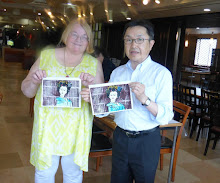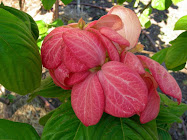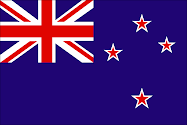Thursday 4 January
Coming back from the Hole in the Rock cruise, for an extra $4 you can get dropped off at Russell and then get the Russell ferry, the Bay Belle, which runs every 20 minutes back to Paihia, and this is what I did.
Pompallier House
In 1839 French Catholic Bishop Jean Baptiste François Pompallier established a mission at Kororāreka, where a two-storied building, housing a printery, tannery and storehouse, was constructed. When priests of the mission moved on, the building was used as a tannery and, from the 1870s, as a grand private home.
Bought by the government as an historic place in 1943, Pompallier House was for many years presented as a stately residence, with gracious verandahs and gardens.
Pompallier House rear garden and a detailed history
This French factory was built in pioneer New Zealand to print Maori language books for the Roman Catholic Mission. The last remaining building of a once-crowded mission headquarters, it is New Zealand's oldest Catholic building, and the oldest industrial building.
In 1838 three Frenchmen, a bishop, a priest and a brother of the recently-formed Society of Mary landed at the Hokianga. The arrival of a French Catholic Mission in New Zealand outraged the English Church Missionary Society and Wesleyan missionaries, who despised Catholicism and thought Maori should be Protestant. It also disturbed the British Resident at Waitangi, James Busby, who feared colonisation by France. But despite their hostility Bishop Jean-Baptiste François Pompallier's mission survived.
Reinforced by the arrival of more French Marist recruits, the Bishop moved to the Bay of Islands in 1839 to found the headquarters of his Vicariate of Western Oceania at Kororareka (now Russell). Kororareka, just across the water from the Protestant Church Missionary station at Paihia and James Busby's Residence at Waitangi, was by now the major trading port of the South Seas. New French Catholic recruits and supplies arrived here from France and were despatched around New Zealand and the Western Pacific. From here Bishop Pompallier and his confreres attended Treaty negotiations at Waitangi in February 1840. And they were here when war broke out on the neighbouring hillside five years later.
Our Lady of Mount Carmel
The narrow site and single, simple building that the Bishop purchased here soon became crowded with a chapel, cookhouse, well house, workshop, houses for Maori visitors and boatmen, and other outhouses. But the Marists knew that to spread Catholicism and to counter the "heresy" of their Protestant rivals they must produce religious texts in Maori. Spurred by the arrival of a printer and printing tools and equipment, they built a printery in 1841-42.
Short of funds, they resorted to the construction traditional to their native Lyon and Rhone Valley in the south of France. The lower storey is made of pise de terre, or rammed earth. The upper storey in pan de bois, or earth panels in a timber frame. The resulting impressive and elegant two-storey French colonial building, completed in 1842, has been a key feature of the town ever since.
In October 1842 the first Maori translations were ready and the printery, complete with bookbindery and tannery, began production. Its crowning achievement was 6,000 handmade copies of the 648-page Ko te Ako me te Karakia o Te Hahi Katorika Romana (The Teachings and Prayers of the Roman Catholic Church).
Religious Artefacts
By 1850, disagreement between Bishop Pompallier and the Marist Society, together with the demands of the growing colony, had led to their moving to Auckland and Wellington respectively. In 1856 the Kororareka mission property was sold to James Callaghan, who tanned leather in the printery until 1863, then moved into it with his family. By 1879, when the Greenways acquired the property, the building was derelict. But Hamlyn Greenway transformed it into an elegant home while his sister, Jane Mair, created a garden from the once-crowded mission compound and the neighbouring property, which Hamlyn also acquired. Then in 1904 the Stephenson family moved in and further developed both house and garden.
All of the families altered the building to suit themselves, but in doing so weakened it. This problem was compounded in 1943 when the Government transformed the house into a historic monument, "Pompallier House". The New Zealand Historic Places Trust took responsibility for the building in 1967. Realising that its history had been misunderstood (it had never been a bishop's palace) and that it had been structurally degraded, in 1990-93 the situation was resolved by returning the building to its original form in a restoration project that was a milestone for New Zealand heritage conservation.
The printery including the original printing press, bookbindery and tanning pits are again working to produce reproductions of the Roman Catholic prayer and instruction books that were printed here in the Maori language through the 1840s. The printery is the only building to survive of the crowded mission site.
The site of the first Roman Catholic chapel is marked in the beautiful garden that was created around 1880 long after the mission was disestablished. The garden is restored to its full glory as the Victorian/Edwardian garden of the later lay owners of Pompallier.
Tēnā koutou katoa
This is all about New Zealand - Aotearoa - and the time I spent there. Magical times, beautiful scenery, gushing geysers, thermal wonderlands. Hear about Waitangi Day, discover the meaning of the word "Aotearoa", see the Glaciers, read about hangis and Hakas, and visit the beautiful Bay of Islands. So come with me on a journey - a journey to The Land of The Long White Cloud.
Kia ora
CHRISTCHURCH EARTHQUAKE TRIBUTE 2011
Kia ora










No comments:
Post a Comment